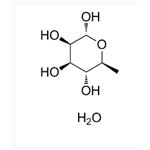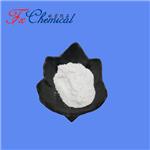L-Rhamnose Monohydrate: dehydration mechanism and ionizing radiation
Introduction
L-rhamnose, a pivotal 6-deoxy sugar, is ubiquitous in a diverse array of natural products, glycoproteins, and structural polysaccharides, predominantly existing in its L-form (L-Rhamnose monohydrate). As a major sugar component of the O-antigen, L-rhamnose enhances the antigenicity of vaccines targeting tumor-associated carbohydrate antigens (TACAs) when it is incorporated. Notably, Sarkar et al. demonstrated that the conjugation of L-rhamnose with carbohydrate antigens effectively bolstered the immune response in mice, underscoring its potential in immunotherapy. Furthermore, the inclusion of L-rhamnose as a fundamental component of the Mycobacterium tuberculosis cell wall presents an intriguing avenue for the development of novel anti-Mycobacterium tuberculosis drugs in the fight against tuberculosis. Consequently, L-rhamnose emerges as a compound of substantial research significance and vast application potential in the realm of drug discovery and development. As shown in Figure 1, L-rhamnose and L-rhamnose monohydrate both belong to the P21(4) space group crystal structure but differ in terms of crystal symmetry and unit cell parameters. Due to the presence of a molecule of crystalline water, α-type L-rhamnose is also known as L-rhamnose monohydrate. Water molecules enter L-rhamnose through the crystallization process, forming specific intermolecular interactions.[1]

Mechanistic Study of L-Rhamnose Monohydrate Dehydration
To optimize its use as a vaccine adjuvant, it is important to understand the dehydration behavior of L-rhamnose monohydrate, which plays a critical role in modifying its physicochemical properties.This study utilized terahertz time-domain spectroscopy (THz-TDS) technology and Density functional theory (DFT) calculations to investigate the low-frequency vibrations of L-rhamnose and L-rhamnose monohydrate. The findings indicate that THz spectroscopy provides superior qualitative identification of L-rhamnose and L-rhamnose monohydrate compared to Raman and powder X-ray diffraction (PXRD) techniques within the 0.3-2.75 THz frequency range. By utilizing THz spectroscopy to study the dehydration temperature of L-rhamnose monohydrate, Yan et al. found that under vacuum conditions, the monohydrate can be fully dehydrated within 6 min at 100℃. Additionally, solid-state DFT calculations revealed that the presence of a single molecule of crystalline water in L-rhamnose monohydrate significantly impacts the THz absorption spectrum through its influence on molecular vibrations. These results not only confirm the effectiveness of THz-TDS technology in the analysis of carbohydrates and their hydrates but also provide valuable insights for monitoring the dehydration process of hydrates. This work highlights the capability of THz spectroscopy to offer detailed structural information and enhances our understanding of the vibrational characteristics associated with hydration changes.[1]
Radical formation from ionizing radiation in crystalline α-L-rhamnose monohydrate
The crystallographic unit cell of α-L-rhamnose monohydrate is monoclinic with dimensions α= 7.901Å, b=7.922Å, c=6.670Å and β=95.521°. There are two asymmetric units per crystallographic unit cell, each consisting of one rhamnose molecule and one water molecule. The crystalline water molecules contribute to form two infinite hydrogen bond chains through the crystal structure along with hydroxyl groups of the rhamnose molecules. One chain is along the b-direction of the crystal [O4–H–Ow–H–]∞ and the other is along the c-direction[O1–H–O2–H–Ow–H–]∞. These two chains are intersecting at the water molecules, and are consequently connected. They have previously been found to play an important role for the selectivity of oxidative radical formation in this crystal. To properly include this important feature and to separate radical fragments from their images in the periodic calculations, the crystallographic unit cell was doubled in all directions, yielding a (2a2b2c) supercell containing 416 atoms.
As the chemical structures of radiation damaged molecules may differ greatly from their undamaged counterparts, investigation and description of radiation damaged structures is commonly biased by the researcher. Radical formation from ionizing radiation in crystalline a-L-rhamnose monohydrate has been investigated using a new method where the selection of radical structures is unbiased by the researcher.The method is based on using ab initio molecular dynamics (MD) studies to investigate how ionization damage can form, change and move. Diversity in the radical production is gained by using different points on the potential energy surface of the intact crystal as starting points for the ionizations and letting the initial velocities of the nuclei after ionization be generated randomly. 160 ab initio MD runs produced 12 unique radical structures for investigation. Out of these, 7 of the potential products have never previously been discussed, and 3 products are found to match with radicals previously observed by electron magnetic resonance experiments.[2]
References
1. Yan B, Hou Z, Zhao Y, Su B, Zhang C, Li K. Mechanistic Study of L-Rhamnose Monohydrate Dehydration Using Terahertz Spectroscopy and Density Functional Theory. Molecules. 2025;30(5):1189. Published 2025 Mar 6. doi:10.3390/molecules30051189
2.Aalbergsjø SG, Pauwels E, Van Yperen-De Deyne A, Van Speybroeck V, Sagstuen E. Automated generation of radical species in crystalline carbohydrate using ab initio MD simulations. Phys Chem Chem Phys. 2014;16(32):17196-17205. doi:10.1039/c4cp02179g
You may like
See also
Lastest Price from α-L-Rhamnopyranose monohydrate manufacturers

US $2.00-5.00/kg2025-07-11
- CAS:
- 6155-35-7
- Min. Order:
- 1kg
- Purity:
- 99%
- Supply Ability:
- 100kg

US $0.00/G2025-04-21
- CAS:
- 6155-35-7
- Min. Order:
- 10G
- Purity:
- 98%min
- Supply Ability:
- 30kg/month


